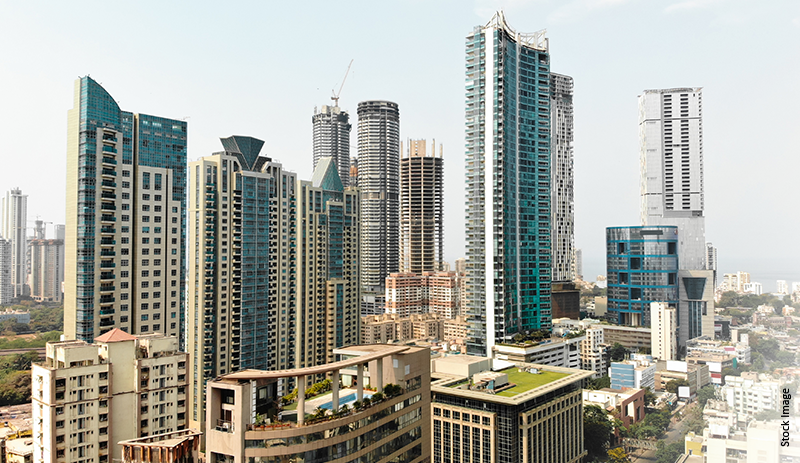11 January, 2024
4 mins read

The rise of tall buildings in India has become a defining feature of urban development in response to India's burgeoning population and shrinking spaces. These towering structures not only offer solutions to the challenge of limited space but also contribute to the creation of vibrant urban landscapes. With their sleek designs and advanced amenities, these tall buildings symbolise India's step towards a more contemporary and efficient urban living experience. They also help accommodate the needs of a growing population in a confined environment.
The way people live in India has undergone a significant change. From housing colonies spreading out horizontally to reaching new heights vertically, there are more and more taller buildings coming up in various nooks and corners of the country.
The predominant housing pattern in earlier times involved independent houses, particularly in smaller towns. However, the scenario has evolved in major cities, necessitating a shift to vertical living. As urban areas face a surge in population, the demand for housing has risen substantially. The surge in demand for housing, fuelled by rural-to-urban migration and population growth, poses a significant challenge in urban planning.
The limitations of available space, coupled with ecological concerns, have compelled urban developers and realtors to rethink traditional housing structures. As a result, tall buildings in India now dominate city skylines.
These towering structures not only optimise land use but also enable more people to occupy the space. With contemporary design and advanced amenities, people are happy to give up the idea of an independent house for the appeal of vertical living with city views.
In the past, tall buildings in India were typically limited to 6 to 8 floors. However, the landscape has transformed dramatically. Today, the country is witnessing skyscrapers soaring to astonishing heights. Home to most of this evolution, Mumbai's tallest building floors range from 80 to 100. The evolution in architectural standards and the advancement of technology have played pivotal roles in redefining the concept of tall buildings in the country. Imagination and cutting-edge technology have added to the number and finesse of these towering structures.
The evolution of tall buildings in India has witnessed a remarkable transformation with the emergence of residential skyscrapers. In the past, the skyline was predominantly occupied by commercial real estate, such as malls and business towers. However, a significant metamorphosis has occurred in recent years, leading the revolution in residential housing spaces, in the city of dreams, Mumbai.
Mumbai stands at the forefront of the vertical revolution in India. Skyscrapers are becoming increasingly popular and the need of the hour, with the list of tallest buildings in Mumbai increasing by the day. Life in a skyscraper in Mumbai marks luxury, comfort, and safety. Contrary to concerns about limited space and privacy, residing in a Mumbai skyscraper offers a grand living experience. These residential towers provide spacious houses, ensuring that residents enjoy ample room for comfort and personal space
These towering structures contribute to a sense of community with expansive amenities. Residents can relish open spaces, parks, cricket fields, community areas, gyms, and more. This vertical living experience in Mumbai symbolises a harmonious blend of urban sophistication and quality of life. There are many tall buildings in Mumbai, particularly catering to residential needs. Residential skyscraper Piramal Aranya Arav is one such tall building in Mumbai. Piramal Aranya Arav redefines luxury living and claims the title of the tallest tower in Byculla, South Mumbai. Piramal Aranya Arav is a residential skyscraper that stands at an impressive height of ≈282.2 metres (926 feet) with 52 floors, making it one of Mumbai's tallest structures. Developed by Piramal Realty, this opulent tower offers contemporary amenities and breathtaking panoramic views of the city.
The shift from horizontal to vertical living reflects a significant change in the lifestyle of the Indian populace. The definition of tall buildings has undergone a remarkable change, evolving from modest structures to awe-inspiring skyscrapers that touch the skies. With the surge in demand for housing, urban areas are witnessing the most of this shift. Mumbai stands as a testament to this evolution, with its skyline boasting many tall buildings.
One can take a virtual tool of a tall residential building apartment like the Piramal Aranya in Mumbai and consider investing in this vertical revolution.
Disclaimer- This article is based on the information publicly available for general use as well as reference links mentioned herein. We do not claim any responsibility regarding the genuineness of the same. The information provided herein does not, and is not intended to, constitute legal advice; instead, it is for general informational purposes only. We expressly disclaim /disown any liability, which may arise due to any decision taken by any person/s basis the article hereof. Readers should obtain separate advice with respect to any particular information provided herein.
 Table of Contents
Table of Contents13 December, 2023
05 June, 2023